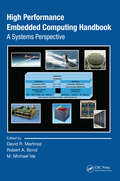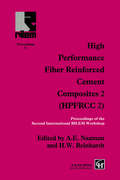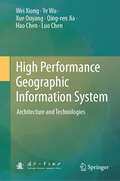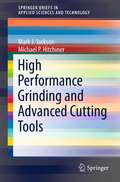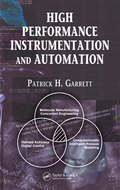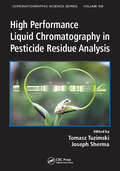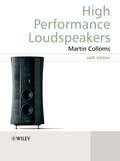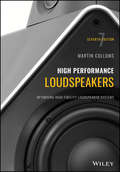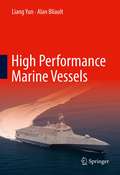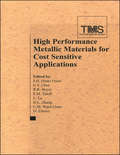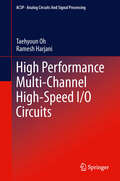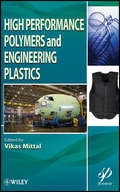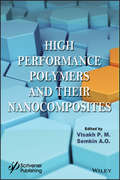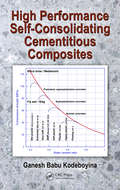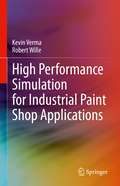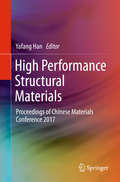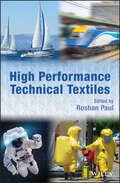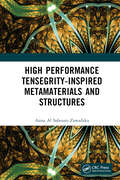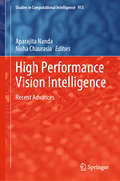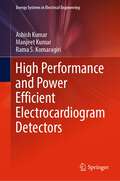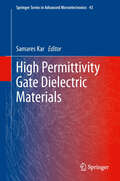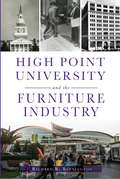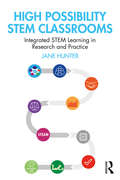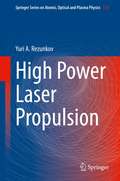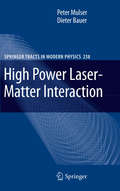- Table View
- List View
High Performance Embedded Computing Handbook: A Systems Perspective
by M. Michael Vai David R. Martinez Robert A. BondOver the past several decades, applications permeated by advances in digital signal processing have undergone unprecedented growth in capabilities. The editors and authors of High Performance Embedded Computing Handbook: A Systems Perspective have been significant contributors to this field, and the principles and techniques presented in the handbook are reinforced by examples drawn from their work. The chapters cover system components found in today’s HPEC systems by addressing design trade-offs, implementation options, and techniques of the trade, then solidifying the concepts with specific HPEC system examples. This approach provides a more valuable learning tool, Because readers learn about these subject areas through factual implementation cases drawn from the contributing authors’ own experiences. Discussions include: Key subsystems and components Computational characteristics of high performance embedded algorithms and applications Front-end real-time processor technologies such as analog-to-digital conversion, application-specific integrated circuits, field programmable gate arrays, and intellectual property–based design Programmable HPEC systems technology, including interconnection fabrics, parallel and distributed processing, performance metrics and software architecture, and automatic code parallelization and optimization Examples of complex HPEC systems representative of actual prototype developments Application examples, including radar, communications, electro-optical, and sonar applications The handbook is organized around a canonical framework that helps readers navigate through the chapters, and it concludes with a discussion of future trends in HPEC systems. The material is covered at a level suitable for practicing engineers and HPEC computational practitioners and is easily adaptable to their own implementation requirements.
High Performance Fiber Reinforced Cement Composites 2: Proceedings of the International Workshop
by H. W. Reinhardt A. E. NaamanThe leading international authorities bring together in this contributed volume the latest research and current thinking on advanced fiber reinforced cement composites. Under rigorous editorial control, 13 chapters map out the key properties and behaviour of these materials, which promise to extend their applications into many more areas in the com
High Performance Geographic Information System: Architecture and Technologies
by Wei Xiong Hao Chen Ye Wu Xue Ouyang Qing-ren Jia Luo ChenThe development of earth observation and computing technology has promoted the wide application of spatio-temporal big data and artificial intelligence. The enrichment of data and the improvement of computational performance make it possible to perform spatio-temporal analysis and computation on a larger scale. Therefore, it is necessary to study the optimization methods and application methods of high-performance geocomputing, starting from GIS architecture, in order to form a high-performance GIS that can serve the society and economy and support various applications. This book focuses on the architecture, technology, platform, and application of high-performance GIS, analyzes the key technologies of spatio-temporal big data organization and access, parallelized spatial analysis and processing, large-scale map rendering, and parallel visualization under the high-performance computing architecture, explains how to build high-performance geographic information applications, and looks forward to the trend of the new generation of GIS.
High Performance Grinding and Advanced Cutting Tools
by Mark J. Jackson Michael P. HitchinerHigh Performance Grinding and Advanced Cutting Tools discusses the fundamentals and advances in high performance grinding processes, and provides a complete overview of newly-developing areas in the field. Topics covered are grinding tool formulation and structure, grinding wheel design and conditioning and applications using high performance grinding wheels. Also included are heat treatment strategies for grinding tools, using grinding tools for high speed applications, laser-based and diamond dressing techniques, high-efficiency deep grinding, VIPER grinding, and new grinding wheels.
High Performance Instrumentation and Automation
by Patrick H. GarrettImprovements in process control, such as defined-accuracy instrumentation structures and computationally intelligent process modeling, enable advanced capabilities such as molecular manufacturing. High Performance Instrumentation and Automation demonstrates how systematizing the design of instrumentation and automation leads to higher performance through more homogeneous systems, which are frequently assisted by rule-based, fuzzy logic, and neural network process descriptions. Incorporate Advanced Performance Enhancements into Your Automation Enterprise The book illustrates generic common core process-to-control concurrent engineering linkages applied to a variety of laboratory and industry automation systems. It outlines: Product properties translated into realizable process variables Axiomatic decoupling of subprocess variables for improved robustness Production planner model-driven goal state execution In situ sensor and control structures for attenuating process disorder Apparatus tolerance design for minimizing process variabilities Production planner remodeling based on product features measurement for quality advancement Coverage also includes multisensor data fusion, high-performance computer I/O design guided by comprehensive error modeling, multiple sensor algorithmic error propagation, robotic axes volumetric accuracy, quantitative video digitization and reconstruction evaluation, and in situ process measurement methods.High Performance Instrumentation and Automation reflects the experience of engineer and author Patrick Garrett, including his role as co-principal investigator for an Air Force intelligent manufacturing initiative. You can download Analysis Suite.xls,, computer-aided design instrumentation software, available in the book's description on the CRC Press website.
High Performance Liquid Chromatography in Pesticide Residue Analysis (Chromatographic Science Ser.)
by Tomasz Tuzimski; Joseph ShermaHPLC is the principal separation technique for identification of the pesticides in environmental samples and for quantitative analysis of analytes. At each stage of the HPLC procedure, the chromatographer should possess both the practical and theoretical skills required to perform HPLC experiments correctly and to obtain reliable, repeatable, and r
High Performance Loudspeakers
by Martin CollomsHigh Performance Loudspeakers, Sixth Edition is a fully revised and updated version of the highly successful guide to the design and specifications of high quality loudspeakers and loudspeaker systems. Each chapter has been substantially revised reflecting the many changes in the technology of loudspeakers. These revisions take the form of much new research and accompanying illustrations, with a radically new theoretical section, allied to in-depth coverage of the most important advances in the art of loudspeaker design. By clearly and practically analysing these many developments the authors have produced an authoritative loudspeaker designer's bible.Key features of the Sixth Edition include:Radically new chapter on acoustic theory, developments in home theatre and surround systems, in speaker system design. Also crossover networks with new digital synthesis methods, and extensive reporting on CAD softwareNew measurement systems and techniques are complemented by recent psychoacoustic research data.Expanded material on sub-sat design, 2pi and boundary speaker design, further work on optimum low frequency synthesis for improved group delay.New materials technology including ceramic and diamond diaphragms, plus first publication of the theory of the BMR, a fascinating hybrid driver technology employing a synthesis of bending wave and pistonic action and which can approach the directivity of a point source.Glossary; a valuable view of electroacoustic terms and definitions to guide all readers.Acknowledged industry-wide as the definitive work on speaker design and analysis, this book is essential reading for audio engineers, speaker designers, equipment designers and students of acoustic engineering, electronics and electro-acoustics. It will also prove invaluable to students of electronics, broadcasting and recording techniques, and be of interest to amateur loudspeaker builders, authors and journalists in audio.
High Performance Loudspeakers: Optimising High Fidelity Loudspeaker Systems
by Martin CollomsProvides a technology overview of what goes into a high performance loudspeaker and covers all the latest advances in the field The design of high performance loudspeakers requires a mix of developed skills in electroacoustics, high fidelity sound reproduction and subjective evaluation. Taking a designer’s view of the subject, this new edition of High Performance Loudspeakers, Seventh Edition provides a comprehensive, timely and practical knowledge base to aid the design of superior loudspeaker systems fit for purpose. It is updated throughout with the latest progress in research and technology, synthesis and analysis, digital signal processing incorporated products, automated production test systems and wireless compact designs. This Seventh Edition of the highly successful guide to the design and specifications of high quality loudspeakers and loudspeaker systems addresses the issue of where higher performance and sound quality is required and shows how the numerous considerations — including application, target price, size, aspiration and particular market — lead to a complex mix of design and engineering decisions. The book has also been substantially revised to reflect the many changes in the technology of loudspeakers and includes two brand new chapters — one covering ultra-compact systems and DSP integration, and the second providing details of a worked example of the loudspeaker systems design process. Offers a complete overview of the technology Thoroughly updated with new content to reflect the latest advances in the field while retaining the firm theoretical foundation of previous editions Presents a designer's point of view of the field, helping to equip both amateur enthusiasts and academically trained graduates with industry practice Covers all the newest developments in the field of high performance loudspeakers Offers a critical and objective approach to all subjects covered, rather than a simple spelling out of theory and facts Appeals to both amateur speaker builders as a source of ideas, and to professional speaker designers with an overview of competitive products and features Acknowledged industry-wide as the definitive work on speaker design and analysis, High Performance Loudspeakers, Seventh Edition is essential reading for audio engineers, speaker designers, equipment designers and students of acoustic engineering, electronics and electro-acoustics. It will also prove invaluable to students of electronics, broadcasting and recording techniques, but will also be of interest to authors and journalists in audio, and not least, amateur loudspeaker builders and enthusiasts.
High Performance Marine Vessels
by Alan Bliault Liang YunHigh Performance Marine Vessels (HPMVs) range from the Fast Ferries to the latest high speed Navy Craft, including competition power boats and hydroplanes, hydrofoils, hovercraft, catamarans and other multi-hull craft. High Performance Marine Vessels covers the main concepts of HPMVs and discusses historical background, design features, services that have been successful and not so successful, and some sample data of the range of HPMVs to date. Included is a comparison of all HPMVs craft and the differences between them and descriptions of performance (hydrodynamics and aerodynamics). Readers will find a comprehensive overview of the design, development and building of HPMVs.
High Performance Metallic Materials for Cost-Sensitive Applications
by C. M. Ward-Close E. S. Chen R. R. Boyer F. H. Froes E. M. Taleff L. Lu D. L. Zhang D. EliezerThese proceedings examine the most recent advances and best practices in structural materials selection, design, and manufacturing for producing affordable components, with a focus on titanium, aluminum, and other advanced metallic materials. This volume discusses melting, casting, powder metallurgy, forging, forming, extrusion, and machining, as well as processing advances, innovative processing techniques, process modeling and materials by design, and new alloys, as well as related processing-microstructure-properties-performance-cost studies. This book can be purchased either on CD-ROM, or portable document format (PDF). PDF and CD-ROM books can be viewed using the free Adobe Acrobat Reader Program on Windows, Macintosh, Unix, and other systems. Access Acrobat Reader through the TMS Document Center at http://doc.tms.org. PDF and CD-ROM books are completely text-searchable, allowing users to locate important information quickly by typing in key words.A collection of papers from the 2002 TMS Annual Meeting and Exhibition held in Seattle, Washington, February 17-21, 2002.
High Performance Multi-Channel High-Speed I/O Circuits
by Ramesh Harjani Taehyoun OhThis book describes design techniques that can be used to mitigate crosstalk in high-speed I/O circuits. The focus of the book is in developing compact and low power integrated circuits for crosstalk cancellation, inter-symbol interference (ISI) mitigation and improved bit error rates (BER) at higher speeds. This book is one of the first to discuss in detail the problem of crosstalk and ISI mitigation encountered as data rates have continued beyond 10Gb/s. Readers will learn to avoid the data performance cliff, with circuits and design techniques described for novel, low power crosstalk cancellation methods that are easily combined with current ISI mitigation architectures.
High Performance Polymers and Engineering Plastics
by Vikas MittalThis book describes advances in synthesis, processing, and technology of environmentally friendly polymers generated from renewable resources. With contents based on a wide range of functional monomers and contributions from eminent researchers, this volume demonstrates the design, synthesis, properties and applications of plant oil based polymers, presenting an elaborate review of acid mediated polymerization techniques for the generation of green polymers. Chemical engineers are provided with state-of-the-art information that acts to further progress research in this direction.
High Performance Polymers and Their Nanocomposites
by Visakh P. M. Semkin A. O.“High Performance Polymers and Their Nanocomposites” summarizes many of the recent research accomplishments in the area of high performance polymers, such as: high performance polymers-based nanocomposites, liquid crystal polymers, polyamide 4, 6, polyamideimide, polyacrylamide, polyacrylamide-based composites for different applications, polybenzimidazole, polycyclohexylene dimethyl terephthalate, polyetheretherketone, polyetherimide, polyetherketoneketone, polyethersulfone, polyphenylene sulphide, polyphenylsulfone, polyphthalamide, Polysulfone, self-reinforced polyphenylene, thermoplastic polyimide.
High Performance Self-Consolidating Cementitious Composites
by Ganesh Babu KodeboyinaThis book attempts to bring together some of the basic intricacies in the production of the complete range of self-consolidating cementitious composites, with a proper understanding of the contributions of different materials and their combinations, including performance and limitations. <P><P>Presents a comprehensive perspective of the state of the art in self-compacting concretes while explaining the basic background and principles, includes possible alternatives of making SCC with different powder extenders and pozzolanic materials <P><P>Explores concepts through theoretical and graphical representations
High Performance Simulation for Industrial Paint Shop Applications
by Robert Wille Kevin VermaThis book describes the current state of the art for simulating paint shop applications, their advantages and limitations, as well as corresponding high-performance computing (HPC) methods utilized in this domain. The authors provide a comprehensive introduction to fluid simulations, corresponding optimization methods from the HPC domain, as well as industrial paint shop applications. They showcase how the complexity of these applications bring corresponding fluid simulation methods to their limits and how these shortcomings can be overcome by employing HPC methods. To that end, this book covers various optimization techniques for three individual fluid simulation techniques, namely grid-based methods, volumetric decomposition methods, and particle-based methods.
High Performance Structural Materials: Proceedings of Chinese Materials Conference 2017 (Materials Science Forum Vol. 816 Ser.)
by Yafang HanThis proceedings volume gathers selected papers presented at the Chinese Materials Conference 2017 (CMC2017), held in Yinchuan City, Ningxia, China, on July 06-12, 2017.This book covers a wide range of powder metallurgy, high performance aluminum alloys, high performance titanium & titanium alloys, superalloys, metal matrix composite, space materials science and technology, rare metals, refractory metals and their applications, advanced ceramics materials, nanostructured metals and alloys. The Chinese Materials Conference (CMC) is the most important serial conference of the Chinese Materials Research Society (C-MRS) and has been held each year since the early 1990s. The 2017 installment included 37 Symposia covering four fields: Advances in energy and environmental materials; High performance structural materials; Fundamental research on materials; and Advanced functional materials. More than 5500 participants attended the congress, and the organizers received more than 700 technical papers. Based on the recommendations of symposium organizers and after peer reviewing, 490 papers have been included in the present proceedings, which showcase the latest original research results in the field of materials, achieved by more than 300 research groups at various universities and research institutes.
High Performance Technical Textiles
by Roshan PaulAn authentic resource for the fundamentals, applied techniques, applications and recent advancements of all the main areas of technical textiles Created to be a comprehensive reference, High Performance Technical Textiles includes the review of a wide range of technical textiles from household to space textiles. The contributors—noted experts in the field from all the continents—offer in-depth coverage on the fibre materials, manufacturing processes and techniques, applications, current developments, sustainability and future trends. The contributors include discussions on synthetic versus natural fibres, various textile manufacturing techniques, textile composites and finishing approaches that are involved in the manufacturing of textiles for a specific high performance application. Whilst the book provides the basic knowledge required for an understanding of technical textiles, it can serve as a springboard for inspiring new inventions in hi-tech fibres and textiles. This important book: Contains a unique approach that offers a comprehensive understanding of the manufacturing and applications of technical textiles Includes a general overview to the fundamentals, current techniques, end use applications as well as the most recent advancements Explores the current standards in the industry and the ongoing research in the field Offers a comprehensive and single source reference on the topic Written for academics, researchers and professionals working in textile and related industries, High Performance Technical Textiles offers a systematic, structured, logical and updated source of information for understanding technical textiles.
High Performance Tensegrity-Inspired Metamaterials and Structures
by Anna Al Sabouni-ZawadzkaFollowing current trends toward development of novel materials and structures, this volume explores the concept of high-performance metamaterials and metastructures with extremal mechanical properties, inspired by tensegrity systems. The idea of extremal materials is applied here to cellular tensegrity lattices of various scales. Tensegrity systems have numerous advantages: they are lightweight, have a high stiffness-to-mass ratio, are prone to structural control, can be applied in smart and adaptive systems, and exhibit unusual mechanical properties. This study is focused on tensegrity lattices, whose inner architecture resembles that of cellular metamaterials, but which are aimed at civil engineering applications in non-material scales. It proposes a methodology for investigation of extremal mechanical properties of such systems, based on discrete and continuum approaches, including the discussion on scale effects. It proves that, similarly to tensegrity-based metamaterials, tensegrity metastructures are able to exhibit extremal mechanical behaviour. This book is directed to researchers and scientists working on metamaterials and tensegrity systems, developing energy-absorption solutions for building and transport industry. The findings described in this monograph can also be useful in other fields of applied sciences, such as civil engineering, robotics and material science.
High Performance Vision Intelligence: Recent Advances (Studies in Computational Intelligence #913)
by Aparajita Nanda Nisha ChaurasiaThis book focuses on the challenges and the recent findings in vision intelligence incorporating high performance computing applications. The contents provide in-depth discussions on a range of emerging multidisciplinary topics like computer vision, image processing, artificial intelligence, machine learning, cloud computing, IoT, and big data. The book also includes illustrations of algorithms, architecture, applications, software systems, and data analytics within the scope of the discussed topics. This book will help students, researchers, and technology professionals discover latest trends in the fields of computer vision and artificial intelligence.
High Performance and Power Efficient Electrocardiogram Detectors (Energy Systems in Electrical Engineering)
by Ashish Kumar Manjeet Kumar Rama S. KomaragiriThis book details the characteristics of an ECG signal through the functionality and electrical activity of the human heart. This book provides a basic introduction and needs for developing implantable cardiac pacemaker systems. This book provides comprehensive details on ECG signal processing techniques that are useful for fast and accurate diagnosis of cardiovascular diseases. The book discusses the characteristics and parameters of a typical ECG signal and various noises that can corrupt an ECG signal. It also covers various challenges involved in different stages of signal acquisition, preprocessing, and detection of an ECG signal. The book also presents a detailed survey of various ECG signal detection and data compression techniques. The book contains detailed information on ECG signals and various noises that corrupt an ECG signal. It also includes de-noising techniques, ECG peak detection techniques, and ECG data compression techniques. It also includes step-by-step details to design various filters in MATLAB. This book, through detailed explanations, provides the reader with necessary information on ECG signal, ECG signal acquisition process, noise removal techniques, and the detection of ECG peaks.
High Permittivity Gate Dielectric Materials
by Samares Kar"The book comprehensively covers all the current and the emerging areas of the physics and the technology of high permittivity gate dielectric materials, including, topics such as MOSFET basics and characteristics, hafnium-based gate dielectric materials, Hf-based gate dielectric processing, metal gate electrodes, flat-band and threshold voltage tuning, channel mobility, high-k gate stack degradation and reliability, lanthanide-based high-k gate stack materials, ternary hafnia and lanthania based high-k gate stack films, crystalline high-k oxides, high mobility substrates, and parameter extraction. Each chapter begins with the basics necessary for understanding the topic, followed by a comprehensive review of the literature, and ultimately graduating to the current status of the technology and our scientific understanding and the future prospects." .
High Point University and the Furniture Industry
by Richard R. BenningtonHigh Point University was founded in 1924 as a small liberal arts college. The High Point Furniture Market was founded in 1909 and has grown to be the largest wholesale furniture market in the world. Over the past century, the furniture industry and the university have developed an ongoing, mutually beneficial partnership that has resulted in industry-specific programs for students. Discover the history of this relationship and the impact that real-world exposure has had on the students and the industry. Read the stories of several High Point University graduates who are successfully employed in various positions throughout the furniture business. High Point professor Richard Bennington unearths the history of a dynamic partnership.
High Possibility STEM Classrooms: Integrated STEM Learning in Research and Practice
by Jane HunterThis book offers a new, research-based approach to STEM education in early, elementary, and middle years of schooling, concentrating on building teacher agency and integrated approaches to teaching and learning in High Possibility STEM Classrooms. Author Jane Hunter presents a globally oriented, contemporary framework for powerful Integrated STEM, based on mixed-methods research data from three studies conducted in 14 schools in language-diverse, disadvantaged, and urbanized communities in Australia. Theory, creativity, life preparation, public learning, and contextual accommodations are all utilized to help educators create hands-on, inquiry-led, and project-based approaches to STEM education in the classroom. A set of highly accessible case studies is offered that places pedagogy at the center of practice – an approach valuable for researchers, school leaders, and teachers alike. Ultimately, this text responds to the call for examples of what successful Integrated STEM teaching and learning looks like in schools. The book concludes with an evidence-based blueprint for preparing for less siloed and more transdisciplinary approaches to education in schools. Hunter argues not only for High Possibility STEM Classrooms but for High Possibility STEM Schools, enriching the dialogue around the future directions of STEM, STEAM, middle leadership, technological literacies, and assessment within contemporary classrooms.
High Power Laser Propulsion (Springer Series on Atomic, Optical, and Plasma Physics #116)
by Yuri A. RezunkovThis book gives an in-depth analysis of the physical phenomena of thrust production by laser radiation, as well as laser propulsion engines, and laser-propelled vehicles. It brings together into a unified context accumulated up-to-date information on laser propulsion research, considering propulsion phenomena, laser propulsion techniques, design of vehicles with laser propulsion engines, and high-power laser systems to provide movement for space vehicles. In particular, the reader will find detailed coverage of: designs of laser propulsion engines, operating as both air-breathing and ramjet engines to launch vehicles into LEOs; Assembly of vehicles whereby laser power from a remote laser is collected and directed into a propulsion engine; and, the laser-adaptive systems that control a laser beam to propel vehicles into orbits by delivering laser power through the Earth's atmosphere. This book is essential reading for researchers and professionals involved in laser propulsion.
High Power Laser-Matter Interaction
by Dieter Bauer Peter MulserThis book intended as a guide for scientists and students who have just discovered the field as a new and attractive area of research, and for scientists who have worked in another field and want to join now the subject of laser plasmas. In the first chapter the plasma dynamics is described phenomenologically by a two fluid model and similarity relations from dimensional analysis. Chapter 2 is devoted to plasma optics and collisional absorption in the dielectric and ballistic model. Linear resonance absorption at the plasma frequency and its mild nonlinearities as well as the self-quenching of high amplitude electron plasma waves by wave breaking are discussed in Chapter 3. With increasing laser intensity the plasma dynamics is dominated by radiation pressure, at resonance producing all kinds of parametric instabilities and out of resonance leading to density steps, self-focusing and filamentation, described in Chapters 4 and 5. A self-contained treatment of field ionization of atoms and related phenomena are found in Chapter 6. The extension of laser interaction to the relativistic electron acceleration as well as the physics of collisionless absorption are the subject of Chapter 7. Throughout the book the main emphasis is on the various basic phenomena and on their underlying physics.
